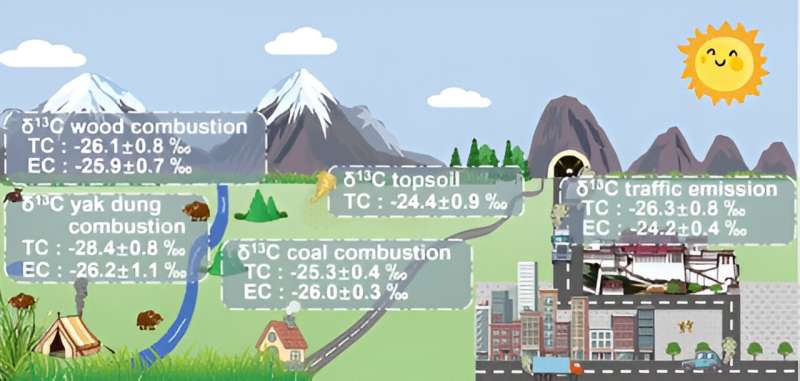This article has been reviewed according to Science X's editorial process and policies. Editors have highlighted the following attributes while ensuring the content's credibility:
fact-checked
peer-reviewed publication
trusted source
proofread
Tibetan Plateau shows unique stable carbon isotope characteristics of carbonaceous aerosol endmembers

Carbonaceous aerosols not only alter the atmospheric radiation budget, but also accelerate glacier melt by reducing the albedo of ice and snow surfaces. However, due to the heterogeneity of carbonaceous aerosols, the identification of their sources and the assessment of their environmental impact pose significant challenges. Carbon isotope (δ13C, Δ14C) technology is an effective tool for identifying the sources of carbonaceous aerosols.
The Tibetan Plateau is one of the richest glacier areas outside of Antarctic and the Arctic. Due to global warming, most glaciers in this region are retreating rapidly, and the impact of carbonaceous particles deposited on glacier surfaces cannot be ignored.
Prof. Kang Shichang's research team from the Northwest Institute of Eco-Environment and Resources of the Chinese Academy of Sciences has revealed the unique stable carbon isotope characteristics of carbonaceous aerosol endmembers on the Tibetan Plateau. The research is published in the journal Environmental Science & Technology.
The researchers collected particulate matter samples from fossil fuel emissions (traffic and coal combustion), and biomass combustion emissions (yak dung and wood), and surface soil samples on the Tibetan Plateau.
By analyzing the δ13C characteristics of total carbon (TC), water-insoluble particulate carbon (WIPC), and elemental carbon (EC) in the samples, they found significant differences in the δ13C values of carbonaceous aerosol endmembers between the Tibetan Plateau and other regions.
Due to the high altitude and thin air, particulate matter from fossil fuel combustion in this region has more negative δ13C values compared to other regions. The unique fuel types used here result in particulate matter from biomass fuel combustion having more positive δ13C values compared to other regions.
Furthermore, there are significant differences in δ13C values among different carbon components (TC, WIPC, EC) in yak dung combustion and traffic emissions due to varying combustion efficiencies.
However, no significant differences among different carbon components are observed in coal and wood combustion emissions. The δ13C values of fine topsoil particles (less than 20 μm) are influenced by changes in regional surface vegetation types.
The study improves the understanding of the emission characteristics of carbonaceous aerosols on the Tibetan Plateau and helps to accurately identify their sources in the Tibetan Plateau and its surrounding areas.
It provides data to assess the impact of carbonaceous aerosols on cryospheric melting and climate impacts.
More information: Chao Zhang et al, Stable Carbon Isotope Signatures of Carbonaceous Aerosol Endmembers in the Tibetan Plateau, Environmental Science & Technology (2024). DOI: 10.1021/acs.est.3c09357
Journal information: Environmental Science & Technology
Provided by Chinese Academy of Sciences





















